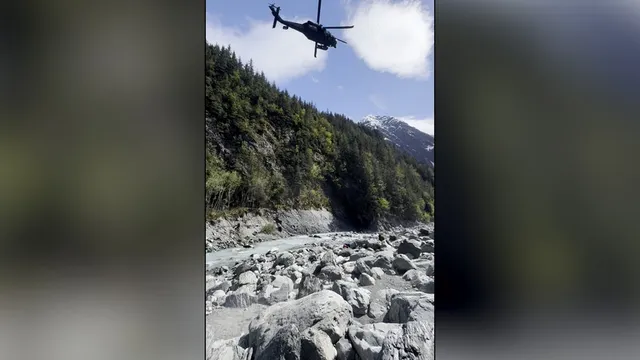
Alaska man survives three-hour ordeal pinned by a 700-pound boulder
2025-05-30 13:23- Kell Morris, 61, was pinned down by a 700-pound boulder in an icy creek for three hours.
- His wife, Jo Roop, prevented him from drowning by holding his head above water while calling for help.
- Morris underwent a dramatic rescue and is expected to fully recover, emphasizing the importance of community assistance.
Express your sentiment!
Insights
In Anchorage, Alaska, a 61-year-old man named Kell Morris faced a harrowing situation last Saturday while on a hike near Godwin Glacier. He was pinned face down in a creek by a 700-pound boulder following a tumble down an embankment that caused the rock to land on his back. His wife, Jo Roop, a retired Alaska State Trooper, managed to hold his head above water for approximately three hours while waiting for emergency responders. Morris was taken to Seward Providence Hospital where he was treated for hypothermia but was reported to make a full recovery shortly after the incident. The incident began when Morris noticed the treacherous terrain, characterized by large boulders along the creek, as he attempted to navigate back. After the ground beneath him gave way, he fell about 20 feet into the water and was immediately struck by the boulder. With rocks positioned under him, he was not crushed, but held pinned in a precarious situation. His wife's quick response allowed her to maintain his airway and prevent drowning while she sought help. She walked approximately 300 yards to connect with 911, utilizing her law enforcement experience to provide critical GPS coordinates to the dispatchers. The actions of Jo Roop were pivotal to the rescue efforts; a volunteer at the Bear Creek Fire Department, who was working at a nearby sled dog tourism company, overheard the emergency call and worked to divert a helicopter to the scene, significantly reducing the time it would have taken for first responders to reach Morris. Firefighters jumped from the hovering helicopter into the boulder field and began the arduous process of lifting the boulder off Morris. They utilized air bags and brute force to successfully complete the rescue, managing to lift it enough to free him from the water. Morris described himself as the luckiest man alive, crediting his survival to both his wife's diligence and the timely assistance from community volunteers who took action in response to the emergency call. Had it not been for the assistance from unrelated businesses like the Seward Helicopter Tours, the outcome could have been fatal. After his rescue, Morris has expressed his intent to stick to established trails during future hikes. The incident underlines the importance of community support and quick decision-making in life-threatening situations.
Contexts
Hiking in Alaska presents a thrilling opportunity for adventure enthusiasts, but it also entails significant risks due to the state's rugged terrain, unpredictable weather, and diverse wildlife. Current safety measures for hikers in Alaska focus on enhancing preparedness and risk mitigation to ensure that individuals can enjoy the breathtaking landscapes of the last frontier without jeopardizing their safety. Hikers are encouraged to educate themselves on the trail conditions, availability of resources such as shelters and water sources, and the potential encounters with wildlife. Essential safety gear, including navigation tools, first aid kits, and communication devices, are vital components that every hiker should carry. The practice of leaving a detailed itinerary with a trusted person and adhering to established trails contributes to overall safety and ensures that help can be summoned if needed. Weather patterns in Alaska are notoriously volatile, which necessitates careful planning regarding timing and duration of hikes. Hikers are advised to check weather forecasts regularly and be equipped to handle sudden changes, such as rain or snow. Wearing layered clothing and waterproof gear can help individuals stay dry and comfortable, while proper footwear is critical for navigating uneven and potentially slippery terrain. Additionally, the state has implemented educational programs aimed at informing hikers about the specific risks associated with alpine conditions, including hypothermia, altitude sickness, and frostbite. These programs often include workshops on recognizing the signs of these conditions and strategies for preventing them, boosting the hikers’ ability to make safe decisions in the field. Wildlife encounters in Alaska can pose unique challenges for hikers. The presence of bears, moose, and other wildlife in hiking areas requires specific safety precautions. Proper food storage techniques, such as using bear-proof containers or hanging food from trees, are strongly recommended to minimize encounters with wildlife. Hikers are encouraged to make noise while walking, travel in groups, and familiarize themselves with how to react appropriately during unexpected animal encounters. Resources provided by the local park services, including wildlife safety brochures and ranger-led educational sessions, play an essential role in enriching hiker knowledge and awareness regarding these critical interactions. Overall, the framework of current safety measures for hikers in Alaska is fundamentally anchored in prevention, education, and preparedness. Local authorities, park services, and hiking organizations have collaborated to create a culture that prioritizes safety and awareness for hikers in this stunning state. Ongoing efforts to promote responsible outdoor recreation practices are crucial to ensuring the well-being of individuals who venture into Alaska's unparalleled wilderness. By adhering to recommended safety guidelines, employing best practices for wildlife encounters, and preparing adequately for fluctuating weather patterns, hikers can greatly enhance their experience while minimizing dangers inherent to this extraordinary environment.